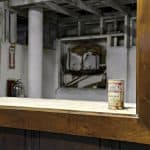The institution which is now commonly referred to simply as Willard has gone by a few names in the past. Willard officially opened in 1869 as Willard Asylum for the Chronically Insane. By 1877 Willard, at 475 acres (1500 patients) was the largest asylum in the United States. In 1995 , the then Willard Psychiatric Center closed its doors for treatment, but a portion of the 13-acre campus remained in use by the New York State Department of Corrections as a rehabilitation facility for inmates..
Obviously, because of the New York State Department of Corrections facility Willard is usually off-limits to the general public. But once a year as a fundraiser the historical society and many volunteers host a 3-hour tour. The D.O.C treatment facility is an intimating section of the Willard campus, surround by 2 rows of high fence with 4 rows of razor wire, the only thing more intimidating was the threat if at any time during the tour, we wandered off or were caught taking pictures of the D.O.C facility we would be removed from the grounds and could have our cameras taken.
I grew up quite a distance from Willard, but the legends and rumors still made it out to my little corner of the world. Horror stories of electroshock therapy, ice baths, and tuberculosis were sometimes heard. While those treatments seem extreme now, they came from a time period where there was a general lack of totally understanding neurological and psychiatric conditions. I am not saying it was a Sandals Resort, but generally the treatments and care of patients at Willard were progressive at the time. Instead of the deplorable conditions and neglect saw at other Asylums and poor houses, Willard provided a protected environment for its patients and encouraged work and self-care.
On Oct. 13,1869, a steamboat docked at Willard and several men led a deformed, demented woman named Mary Rote down the gangplank. Mary was the asylum’s first patient. She had been chained for 10 years without a bed and without clothing in a cell in the Columbia County almshouse.
Three more patients, males, arrived at that day, all in chains, one “in what looked like a chicken crate, 3 1/2 feet square. Many of the early patients had been considered difficult and were “quieted” by regular flogging, dousing and “pulleying” (hanging by the thumbs) in the almshouses. Within days of their arrival at the new asylum, however, they were bathed, dressed, fed and, usually, resting quietly on the wards.
~https://www.asylumprojects.org/index.php?title=Willard_State_Hospital
My morning at the asylum by the lake in Willard NY was fascinating. I have so much to share! I took well over 300 pictures during the tour. Even though I am only planning on using a fraction of those pictures here, it is still too much for one post. I have broken down my Willard visit into an individual post for each building, you can click any of these building links to get started:
More about Willard
BOOKS ABOUT WILLARD
- The Lives They Left Behind: Suitcases from a State Hospital Attic
, by Darby Penney, Peter Stastny, and Lisa Rinzler
- The Inmates of Willard 1870 to 1900: A Genealogy Resource
, by Linda S. Stuhler
- What She Left Behind
by Ellen Marie Wiseman Fictional story, but very good read!

























































